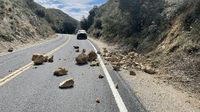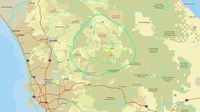A 5.2 magnitude earthquake shook Southern California on Monday, April 14, 2025, according to the U.S. Geological Survey. The quake, which struck at approximately 10:10 a.m., was centered in Julian, San Diego County, and was felt as far north as Los Angeles and south into Tijuana, Mexico. Fortunately, no injuries or significant damage have been reported, as confirmed by Cal Fire San Diego and the San Diego County Sheriff's Department.
Seismologist Dr. Lucy Jones noted that the earthquake followed a 3.3 magnitude foreshock that occurred the previous day, on April 13. In addition, several aftershocks in the 2 to 3 magnitude range were recorded after the main quake. "Extreme damage is not expected," Jones stated, although she cautioned that older buildings or those with poor foundations might be at risk.
Witnesses described the quake's intensity. Laura Acevedo, a reporter at San Diego ABC affiliate KGTV, recounted her experience in the newsroom during the tremor. "It felt like someone was shaking the ground from under me," she said. "Everything started shaking... desks shaking, TV screens. This was one of the two worsts I’ve ever felt."
Greg Allen, a visitor from Washington, also shared his experience. "The building rocked for a long time. Everything was moving, the blinds and everything," he said. "Then we heard people going down the stairs. And since we're from out of town, we figured we should probably leave the building also."
In a remarkable display of instinct, elephants at the San Diego Zoo Safari Park reacted to the earthquake by forming an “alert circle” around their young. The herd, consisting of elder elephants Ndlula, Umngani, and Khosi, quickly moved to protect the juveniles as the ground shook.
Mindy Albright, curator of mammals at the zoo, explained the behavior, saying, "It was really neat to see them come together as a herd to protect the juvenile and then immediately try to survey their habitat." The elephants paused after forming the circle, using their acute sense of hearing to assess their surroundings. After about four minutes, they determined the danger had passed and exited the circle, although they remained close together.
Albright noted the significance of the herd's actions, particularly highlighting the behavior of the young elephant Zuli, who positioned himself on the outside of the circle. "To see that evolution of his social responsibility within the herd is really interesting," she remarked. African elephants typically live to be 60 to 70 years old in the wild, benefiting from their protective family structures.
The alert circle behavior is not new for these elephants; they exhibited similar actions during the magnitude 7.2 Baja California earthquake in 2010. This instinctive response underscores the strong social bonds and communication skills within elephant herds. Albright added, "Elephants are very unique. I think one of the things that makes them so likable is their connectedness to each other, which you can really see in moments like these."
The earthquake also tested California's early earthquake warning system, which successfully notified users in some areas before they felt the shaking. This technology aims to provide a safety buffer for residents in earthquake-prone regions.
The tremors were felt across a wide area, with residents reporting a strong jolt. The San Diego County Sheriff's Department confirmed that they had not received any reports of damage or injuries in the immediate aftermath of the earthquake. However, transportation services were affected, with delays reported as authorities assessed the situation.
In light of this event, California Gov. Gavin Newsom has been briefed and the state is coordinating with local authorities to ensure public safety and to monitor any potential aftereffects of the quake.
As the community processes the event, many are reminded of the importance of preparedness in the face of natural disasters. The earthquake serves as a stark reminder of California's seismic activity and the need for continued vigilance.
Overall, Monday's earthquake was a significant event for Southern California, but thanks to the preparedness of both residents and emergency services, the impact was mitigated. As the dust settles, the story of the elephants at the San Diego Zoo serves as a heartwarming reminder of the instinctual behaviors that can emerge during crises.







